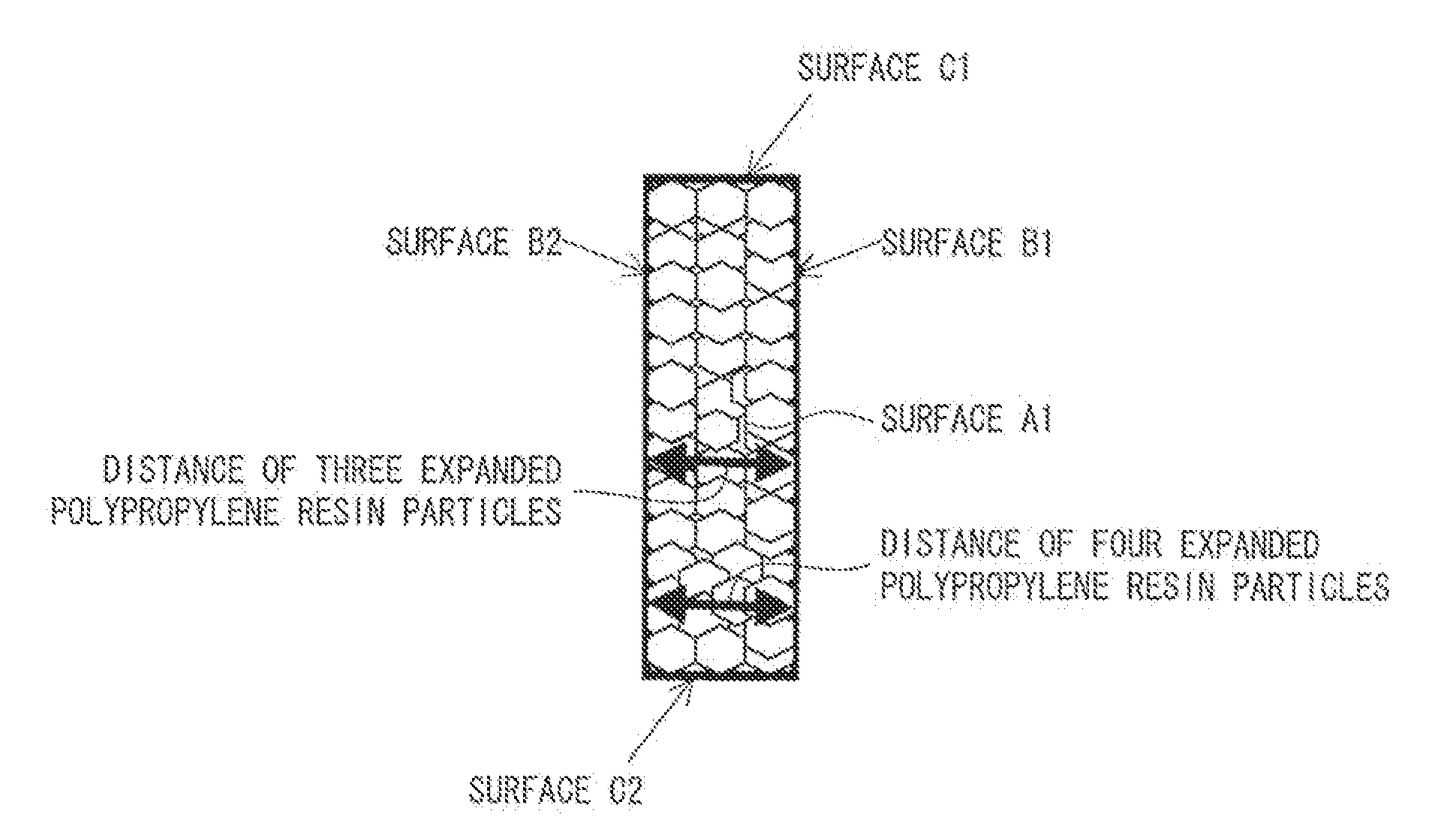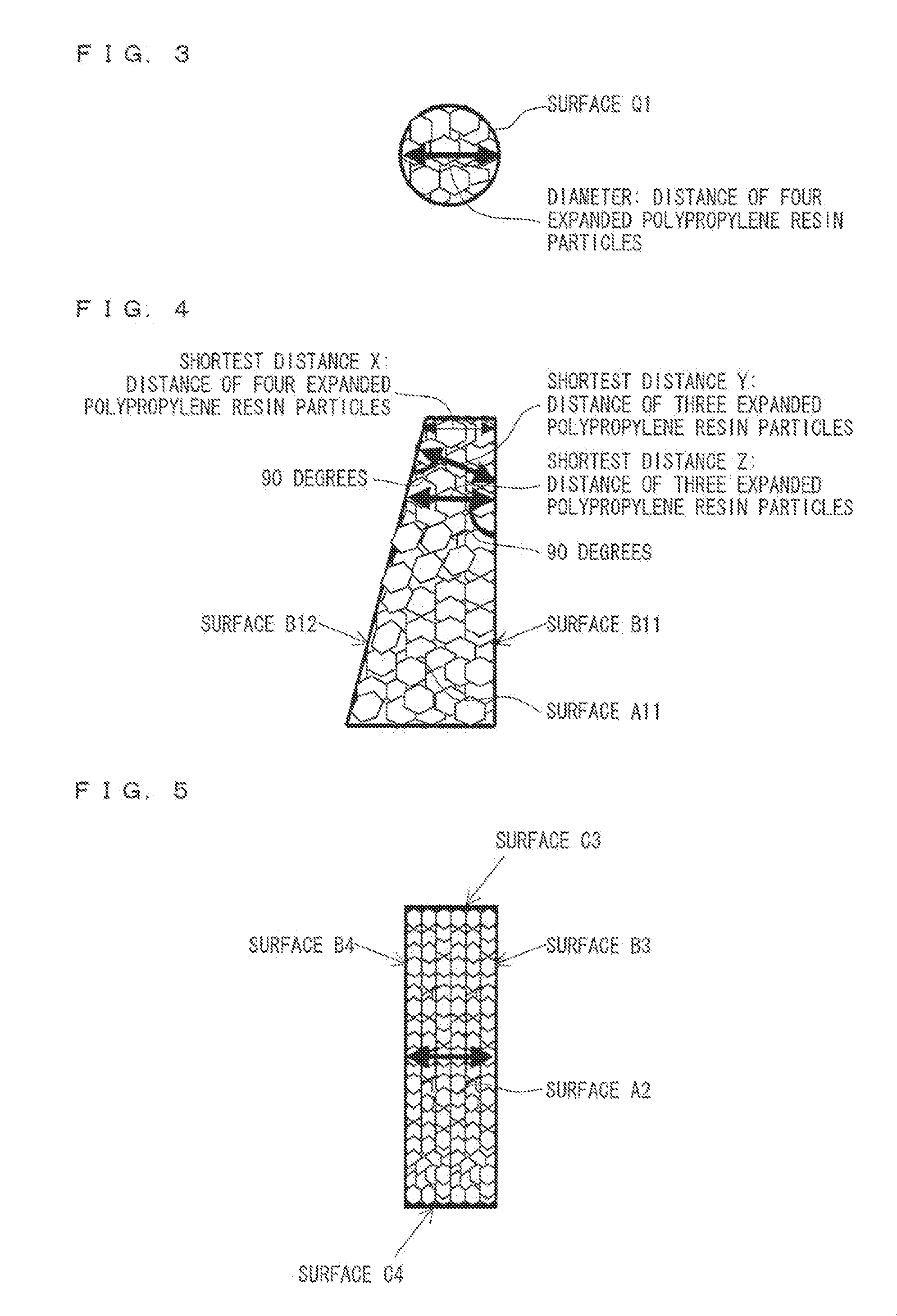In-mold foam molded body comprising polypropylene resin foam particles and method for producing same
- Summary
- Abstract
- Description
- Claims
- Application Information
AI Technical Summary
Benefits of technology
Problems solved by technology
Method used
Image
Examples
examples
[0168]Next, the present invention is described with reference to Examples and Comparative Examples. It should be noted, however, that the present invention is not limited to the Examples below.
[0169]The Examples and Comparative Examples used the following polypropylene resins and additives.
[0170](1) Polypropylene Resins[0171]Polypropylene resin A (F227A available from Prime Polymer Co., Ltd.): An ethylene / propylene random copolymer having a melting point of 143° C., an ethylene content of 3.6 weight %, and an MI of 7.0 g / 10 minutes[0172]Polypropylene resin B (E314M available from Prime Polymer Co., Ltd.): An ethylene / butene-1 / propylene random copolymer having a melting point of 145° C., an ethylene content of 3 weight %, a butene-1 content of 1.5 weight %, and an MI of 5.0 g / 10 minutes
[0173](2) Aliphatic Diethanolamine Fatty Acid Ester[0174]Stearyl diethanolamine monostearic acid ester (Electrostripper TS-6B available from Kao Corporation)
[0175](3) Aliphatic Diethanolamines[0176]Ste...
reference example 1
[0225]Reference Example 1 was totally identical to Comparative Example 1 except that Reference Example 1 employed a mold which molded a rib having an external dimension of 50 mm in length, 15 mm in width, and 120 mm in height. Evaluation was carried out for surface appearance of a part (that is the rib) having an external dimension of 50 mm in length, 15 mm in width, and 120 mm in height. A result of the evaluation is shown in Table 2.
TABLE 1Examples123456Polypropylene resin APBW100100100100100100Polypropylene resin BPBWAliphaticStearyl diethanolaminePBW0.151.50.090.60.60.6diethanolaminemonostearic acid esterfatty acid esterAliphaticStearyl diethanolaminePBW0.110.060.40.4diethanolamineLauryl diethanolaminePBW0.4AliphaticStearyl alcoholPBWalcoholLauryl alcoholPBWOther mainN-hydroxyethyl-N-[2-hydroxyalkyl]aminePBWadditivesGlycerin stearic acid esterPBWOther additivesPolyethyleneglycolPBW0.20.20.20.20.20.2TalcPBW0.150.150.150.150.150.15MelaminePBWExpandedFirst-stageCarbon dioxide amoun...
example 30
Preparation of Polypropylene Resin Particles
[0240]A mixture was prepared by mixing a polypropylene resin and additives of kinds and amounts shown in Table 5 and 0.01 part by weight of the organic pigment Perylene Red together. The mixture was (i) kneaded in an extruder having a diameter of 50 mm (resin temperature of 210° C.), (ii) extruded from an end of the extruder into a strand shape, and (iii) granulated by cutting the extruded in the strand shape. This produced polypropylene resin particles (1.2 mg per particle).
[0241][Preparation of Expanded Polypropylene Resin Particles]
[0242]Into a 10-L pressure-resistant vessel were fed (i) 300 parts by weight of water, (ii) 100 parts by weight of the polypropylene resin particles produced, (iii) 1.2 part by weight of tertiary calcium phosphate serving as a dispersion agent, and (iv) 0.05 part by weight of sodium normal paraffin sulfonate serving as a dispersion auxiliary agent. Further, 15 parts by weight of isobutane was fed into the pre...
PUM
| Property | Measurement | Unit |
|---|---|---|
| Fraction | aaaaa | aaaaa |
| Fraction | aaaaa | aaaaa |
| Percent by mass | aaaaa | aaaaa |
Abstract
Description
Claims
Application Information
 Login to View More
Login to View More - R&D
- Intellectual Property
- Life Sciences
- Materials
- Tech Scout
- Unparalleled Data Quality
- Higher Quality Content
- 60% Fewer Hallucinations
Browse by: Latest US Patents, China's latest patents, Technical Efficacy Thesaurus, Application Domain, Technology Topic, Popular Technical Reports.
© 2025 PatSnap. All rights reserved.Legal|Privacy policy|Modern Slavery Act Transparency Statement|Sitemap|About US| Contact US: help@patsnap.com



